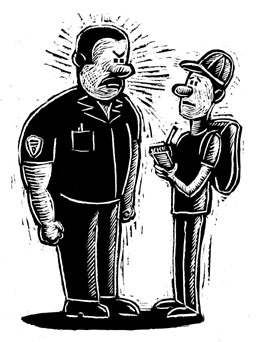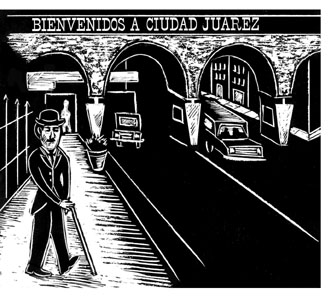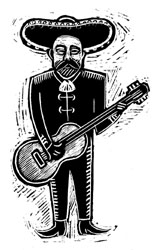⁄ Donde Est Artaud?
?Donde Est? Artaud?
The Tarahumaras visit the cities sometimes, drawn by a desire to travel, to see, as they say, how the mistaken men live. For them, living in the city is a mistake.
–Antonin Artaud, Voyage to the Land of the Tarahumara
I’m no cartographer, nor do I have any drawing skills, but for the last two years I’ve been mapping various streets in Juárez and El Paso that I’ve been driving or walking through all my life. I’m interested in certain “zones” within our city, their ambience and history, and the effect they have on our collective psyche. I’m not sure why I’m making these maps. It’s become a sort of obsession with me. To a large degree I’m following the lead of the Situationnistes, an obscure and defunct group of avant-garde artists and urbanists.
In 1954, the Situationnistes began a series of urban explorations they called experimental dérives. Groups of them would drift through European cities with no plan or direction charting psychogeographical ambiences, making maps of the vibes they got from each zone as they went about looking for the city’s soul, its hidden poetry. They hoped the results of their cartography would form the basis of la révolution quotidienne–the transformation of everyday life. With their maps they were supposed to create new cities out of old zones. One of the founders of situationisme, the 19-year-old Parisian Gilles Ivain, drifted into the Bizarre Zone, the Happy Zone, the Noble Zone, the Utilitarian zone, and the Sinister Zone. For some reason he never came out. He wrote one brilliant piece and never wrote again. Some say he got lost, went crazy, ended up in the Insane Asylum Zone. Maybe he became un beatnik. Who knows?

I’m too burned out to become a beatnik, or even a revolutionary, but I was captivated by the idea of drifting through our cities, and without regard to Migra-created barriers, making an emotional vibe-zone map of La Frontera. Recently I spent some time drifting aimlessly through two Juárez streets with quite a reputation for history and sin–Avenida Juárez and La Mariscál.
I started out on the American side of the Santa Fe bridge, where the barbed wire begins, let’s just call it La Zona de Nadie. I was jotting down notes here–clothes by the pound, plastic bags trapped on barbed wire, a soldier with chain saw helps U.S. Customs agent cut through impounded car’s gasoline tank, etc.–when a security guard who thought my act of writing seemed suspicious came up and asked to see my ID. In La Zona de Nadie everyone has to answer three sixty-thousand-dollar questions quickly.
“Who are you?”
“I’m not sure.”
“Where are you from?”
“I think some of my ancestors crossed the Bering Strait and others drifted in from the ocean.”
“Where are you going?”
“I’m going to do a psychogeographical map of the border.”
The zones aren’t static, they ebb and flow like tides. When Pee Wee Russell played at the Big Kid’s Palace in the early ’20s, the whole Avenida Juárez from the Santa Fe Bridge to Calle Comercio (today known as Diez y Seis de Septiembre) was a ludic zone for tourists. After he’d finish blowing his horn–Pee Wee was playing the sax back then–he would hire a cop for a dollar a night as a bodyguard, get drunk, and go watch badger-bulldog fights for fun. From prohibition to the forties, Hollywood stars like John Wayne and Robert Mitchum as well as Fort Bliss soldiers would hang out in Avenida Juárez watching Copa Cabana-style dancing girls with the big feathers on their derrieres. Charlie Chaplin came to Avenida Juárez in 1942, not to catch the show, but to get a quickie divorce from Paulette Goddard.
Until the sixties and seventies the low-down dirty avenue was a must stop for African-American musicians on tour. Blues guitarist Long John Hunter played at the Lobby for years before one agent from some important city “discovered” him. A jam session regular would sit in a corner booth and play with himself while listening to the moans and screams of Long John’s instrument. In the seventies, Oscar Zeta Acosta, who wrote The Revolt of the Cockroach People, got arrested here. The whole street was a gas.
But now the Avenida Juárez enclave for Drunk American Kiddies is only about two blocks deep. Most of the high schoolers seeking to escape El Paso curfew laws and drinking ages don’t venture farther than Shooters, an American sports bar. There are lots of pharmacies in this zone with bright posters advertising specials on Viagra and over-the-counter antibiotic cures for sexually transmitted diseases.
If you take a right to La Mariscal, or La Calle del Diablo, as it was called back when the major battle of the Madero Revolution was fought in Juárez in 1911, you’ll notice a different crowd. This is the Hard Core Zone.
El Paso photographer Richard Baron used to hang out here working on his series–Whorehouse Self-Portraits. Photography can be dangerous here. While walking around with my digital camera one evening I snapped a couple of pictures of Norteño musicians in front of a bar. Two thugs wearing large gold Virgin Mary medallions around their necks who had been sitting next to the bar ran up to me. Why did you take a picture of us man? I apologized profusely, explained I was shooting the musicians not them, deleted a picture where one of the thug’s back showed up, and they let me go. Órale pues, don’t take any more pictures, alright?
Further down the street at the Queens night club, a Step-Right-Up guy comes up to me.

“Éntrele, compita. If you don’t like the place, you don’t have to stay.”
I walk in. There are moving pictures on a giant video screen while a woman does a pole dance. (The first moving pictures ever shown in El Paso were projected from an Edison vitascope on October 16, 1896, at the Myar’s Opera house in downtown. The crowd got a huge laugh when they saw scenes of a black man enjoying his watermelon. They also got to see a bathing scene, a bicycle parade, and a lynching.) At Queens a video is running of a man trapped inside a burning building. The firemen who can’t get to him douse him with water to keep him from burning. All the while a flesh and blood woman wriggles down to her G-string.
It’s a slow night. There are only three men in the whole joint and about 20 working women, bored out of their wits, waiting for non-existent customers. All business in Juárez, including the maquiladora industry, has been slow since Osama blew up the Twin Towers. One of the guys looks like a young Mexican pimp with lots of brillantina on his hair. Another looks like the El Paso poet Gene Keller–an ex-hippie with long, albino-white hair, Bermuda shorts, and white tennis shoes, with a Santa Fe air to him. He goes from table to table trying to strike up heavily accented conversations. The previously bored women break into an instant smile, like Taco Bell employees taking an order.
I was the third guy. I don’t tell anyone I was there to do research. When no one was looking I jotted down notes on my two-inch notepad. What I need is an informant, I thought. Maybe I’ll ask the Step-Right-Up-Guy. Or maybe the waiter who brings me a Tecate should be my Dante’s Virgil. He’s about 60 and seems like an articulate man despite his deep silence. (As if he hasn’t talked in 20 years.) He has gravitas. He could have been a television news anchorman, a Walter Cronkite or Peter Jennings of the Juárez night. But I’m not sure what I would ask him. No questions that would get me in trouble of course, nothing that would get me confused with the DEA or anything. I would explain that I’m an intra-urban explorer and that I’m looking for Zones. I heard Juárez used to be at the bottom of the ocean. They say the ocean dried up but if you dig deep enough it’s still there. I want to know what he knows about the human heart, the human condition. I want to know if God–or even Pancho Villa–has ever walked into this place. The stripper music blaring through the speakers is too loud though. I step out of the joint without asking him any questions.
Although Juárez is my motherland, I no longer belong here. My mother was born here and my grandmother died and was buried here. She died of bile and gall bladder stones and too much womanly anger toward that drunk, Indio panadero, cabrón husband of hers–my grandfather.
I have history here, but I’m about as foreign in these streets as Antonin Artaud discussing philosophy with the shy and reclusive Tarahumaras. I’m about as foreign as that goddamned crazy French bastard Artaud barking and barking and barking on a Parisian stage then exiling himself to the copper canyons of Chihuahua because he’s sick of words. He came down to this area in 1936, looking for the edge of the world. If he had come to Juárez, he would have found it.
I look for Artaud’s face among the transvestites walking the street in high heels, who’ve sprayed generous samplings of sweet strawberry perfume on themselves. One of them, with her plaid skirt and trensas (braids), looks like a niña fresa, a private school girl.
¿Dónde está Artaud?
They say Artaud went back to France to intern himself in an insane asylum and write poetry for the surrealists. The surrealists didn’t accept his poems because his rantings were just too crazy, but they did publish a letter from him explaining why his insanity didn’t fit the poetic format. André Breton accepted Artaud into the Surrealist Club but immediately kicked him out. Ese güey está loco, Breton said. Artaud misses Chihuahua terribly. They had him wearing one of those Houdini suits, the same suit Houdini wore when he came to El Paso in 1916 and hung upside down from the telephone wires over Alligator Park. They say Artaud was in the audience when Houdini had himself tied up, upside down in a locked water torture tank.
Around Mariscal and Calle Ugarte you get a different vibe. The best indication of entering and leaving a zone is the music. The bars in this section are no longer blaring cheesy, flamboyant strip-tease American pop. Instead the live Norteño music hits you right in the gut as soon as you walk into La Nacional dance hall. The dance floor is packed with couples of all ages. Los Vagos del Norte–The Vagabonds of the North–are playing tonight. Their bass player looks like Pancho Villa. He stares straight ahead, hardly noticing the dancers. Villa’s hair has whitened some. He’s lost some weight. He seems tired, even a little wiser. Last year he had a dream which instructed him to lay down his 30-30 Mauser and pick up a bajo sexto instead. His eyes stare at a light. He loses himself in the steady pulsations of the bajo sexto. He enjoys being the bass, the ground. Without him and his dronelike, lower register repetitions the music has no foundation, no groove, nothing to dance to.
And dance the people do.
They forget the pollution of the streets, or the fights outside of the dance hall among the street vendors where one of them loses his shirt while the other pounds his face with a closed fist, and before there’s any blood, the weak one says ya estuvo, ya estuvo. The people forget that they lost the revolution a long time ago, or that John Wayne no longer visits their avenue.
They dance as if the sun will never rise again.
I stay there until the band stops playing. Then I drift into other zones.

When Artaud wrote his play, The Conquest of Mexico, he explained he was searching for a non-conceptual theater based on “sounds, groans, secret music, lights and diverse chaotic objects that would unleash confusion on cities.”
Sounds, groans, and secret music play a major part of my psychogeographical search as well. Musicians are my Frontera griots–my true guides to the city’s underground. I listen carefully to their lyrics–their narco-corridos, their code-switching raps, their miscegenated improvisations. If you listen hard enough you can pick out the music that’s suspended in the stratospheres of the various zones–trapped like sweet or noxious fumes inside a dome.
My mapmaking excursions have sometimes taken me away from the streets. They’ve taken me to historical archives in search of old photographs of El Paso and Juárez–from the UTEP special collections library to the Getty Research Institute in Los Angeles and in the future, to the Casasola Archives in Pachuca, Mexico. I don’t always plan what I’m looking for. At the Getty I chanced upon old photos of Ambrose Bierce in El Paso. Bierce, author of The Devil’s Dictionary and inspiration for Carlos Fuentes’ Old Gringo, drifted through Avenida Juárez in 1913 to join up with the Villistas. “Ah, to be a gringo in Mexico–now that’s euthanasia!” he exclaimed when he crossed the border, then completely disappeared.
Psychogeography is a search for the vanished.
I’m on the trail of a half-Yaqui curandera who was forced from one border zone to another. Teresa Urrea was kicked out of Mexico and exiled to El Paso in 1896 after the Mexican dictator Porfirio Díaz accused her of starting a Yaqui Indian uprising at Tomochic. In addition to faith-healer she was also co-editor of an El Paso newspaper and a musician who supported various U.S.-Mexico border uprisings and Wobbly miner strikes in Arizona. Oddly enough the revolutionary healer lived in three different parts of El Paso that still have to do with healing or the Mexican Revolution. The sites of her former residences are now the Tillman Health Center on Campbell street, the former Ladies Hospital on South Oregon, and the present location of the El Paso Historical Society on Yandell. Later she drifted to New York where she won a beauty contest. A century after her death, most of her photographs and personal letters ended up at the Texas Tech archives at Lubbock.
My urban explorations have turned me into somewhat of a historian–not a real one, but a “micro-historian.” I’m not looking for grand explanations or causes belli. Instead I’m looking for the snail trails nomads leave behind. I’m looking for ghosts, little details, clusters of venues, vortexes, geographical nodes, hidden music and the effect they have on our identities and emotions, both conscious and subconscious.
But more than anything, I’m looking for poetry.
David Romo is a writer, musician and editor of El Bridge, where a version of this article first appeared. He is currently working on a book documenting the cultural history of El Paso and Juárez.


